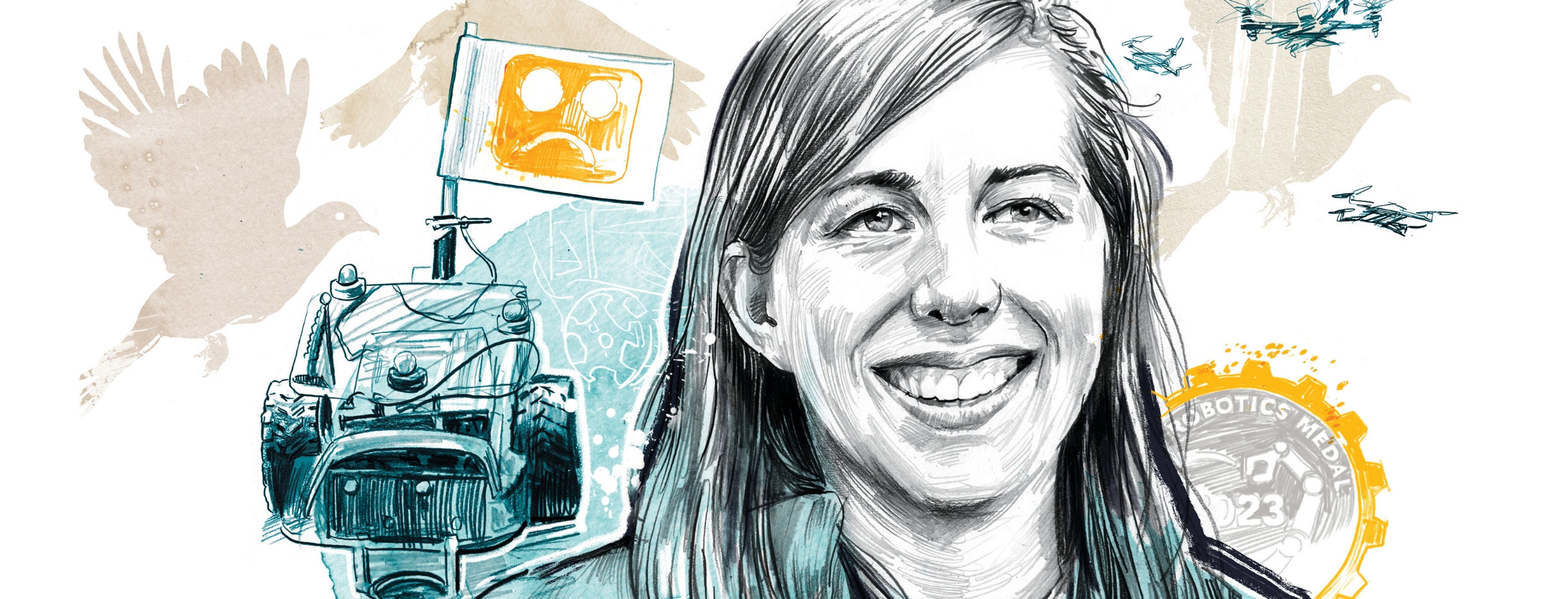Robot Harmony
Alyssa Pierson ’10 and her research team seek to understand and improve the algorithms that power multi-agent robot systems
During her junior and senior years, Alyssa Pierson ’10 worked on a project with engineering professor Lori Bassman modeling the kinematics of pigeons in flight. Unlike most birds, pigeons can make a 90-degree turn in flight, and the researchers were trying to figure out exactly how the birds accomplish this feat.
Pierson, who now studies multi-robot systems, admits that “getting into robotics by way of pigeons is a rather unique way of getting into robotics. It’s not the typical path.”
But like those pigeons, Pierson has made her own in-flight twists and turns during her career. Her junior-year Engineering Clinic project found her working with Nike on a shoe design project. Her senior-year Clinic with the University of Iceland involved the design of a backyard heat waste reclamation system. After Mudd, she was a traveling project engineer, working for one company designing oxygen systems for astronauts and another company that developed concealed audio-video devices.
Today, she is an assistant professor of mechanical engineering at Boston University. “Seeing these many different jobs, these many different things I could work on, I realized that the thing I really liked was the kinematics and dynamics side of the pigeon project I had worked on, alongside some engineering,” she says. “And the intersection of those two things happened to be robotics.”
Pierson’s research centers on multi-agent robot systems, looking at how trust, cooperation and competition operate within and between collaborative robot teams. In graduate school at Boston University, she says, “I became fascinated that you can take a relatively simple robot, that maybe doesn’t have a lot of skills or capabilities, and through some clever design of other relatively simple robots, you can start to create much more complex behaviors of a system.”
Self-driving vehicles—and how they interact with each other, with human drivers and with an ever-changing environment—are a classic example of a multi-agent system that Pierson studies. To understand and improve the algorithms that power these systems, she and her colleagues draw from research in social psychology and behavioral science as well as traditional engineering.
“There’s a lot of interesting game theory problems within the cooperation of these delivery robots.”
Psychology was Pierson’s concentration at Mudd, “so it was always kind of a second technical interest,” she says. “I’ve been excited to bring that into some inspiration for my current research in multi-robot teams.”
She and her team are now looking at the future of automated delivery systems, where drones and sidewalk robots will bring everything from packages to medicines to takeout Thai to your doorstep. What will it be like for all these agents to traverse the streets and skies together?
“One thing we like about the delivery robot problem is that there’s a lot of interesting game theory problems within the cooperation of these delivery robots,” Pierson explains.
Competing companies won’t want to share their algorithms for fast and easy delivery, but robot teams “will encounter each other out in the wild,” she notes. “Ultimately, we want to come up with design policies that still work, that still get people the packages they want, but are robust to the idea that they are cooperating even though they’re not trying to help each other.”
Drones or other autonomous vehicles used for environmental and wildlife monitoring are another focus of Pierson’s team, who are figuring out ways to get these drones to work cooperatively in remote regions that are difficult for humans to reach.
Her lab has a fleet of mini car-like robots that run on small, powerful computers called Jetson Nanos that the researchers can use to test out their theories. “We try to take every paper or concept that we write and instantiate it on a hardware platform,” says Pierson.
Pierson also serves as chief scientist at Ava Robotics, a position that grew out of another mid-career swerve during the COVID-19 pandemic. A postdoc at MIT in 2020, Pierson found her carefully planned research projects abruptly put on hold as the university labs shut down. But through her connections with MIT’s Computer Science and Artificial Intelligence Laboratory, she and a group of students worked with Ava to create a UV disinfection robot for the Greater Boston Food Bank.
At Ava Robotics, “I get to work on immediate, tangible robotics applications and see physical robots get delivered to customers,” Pierson says. “It’s really exciting and fulfilling.”
Although she can’t discuss many of her current projects at the company, she can talk about the telepresence robots that bring remote employees to the workplace and the security robots that patrol warehouses, among other applications. Like the disinfection robot, “it’s the idea that we want robots to augment and aid what we can do in these office environments,” Pierson says. “It’s not a replacement of people.”
In May 2023, Pierson received the inaugural MassRobotics Rising Star award, which recognizes talented women researchers advancing the field of robotics. “You do what you think is exciting and interesting, and I have very much followed the interesting ideas or research that I enjoy,” she says, “so it’s a tremendous honor to hear that this is worthwhile.”
She is also excited that the award will make her “a visible role model within the community, to perhaps play a part in getting more women in engineering” and pay forward the mentoring that has supported her throughout her career.
Pierson’s advice to younger researchers comes from something she learned at Mudd, she says. “Know that if you believe in yourself, the doubt of others doesn’t matter. Remember that you can do a lot, and you can do more than you probably think you can.
“There’s also a saying, ‘stay in your lane,’” she adds. “And I would say you can always choose another lane.”
